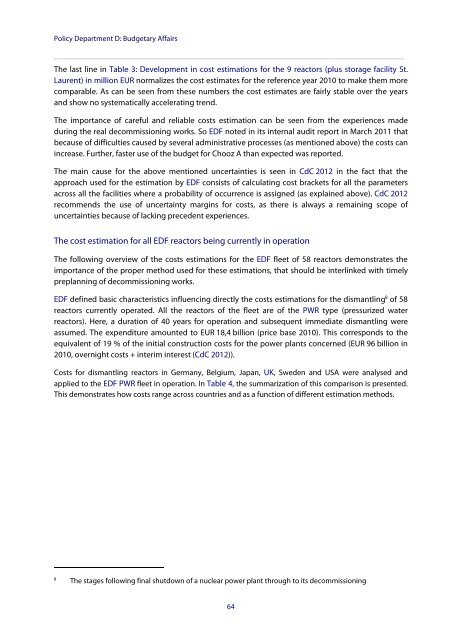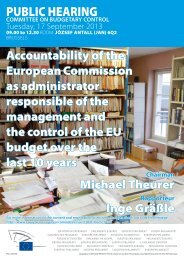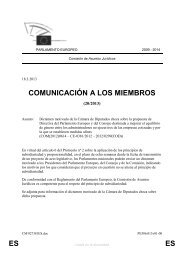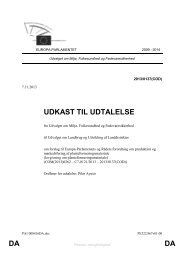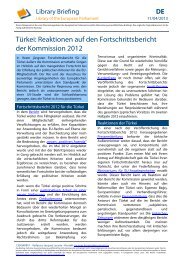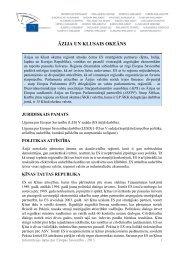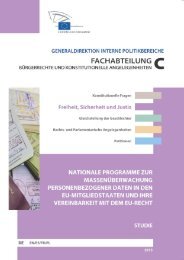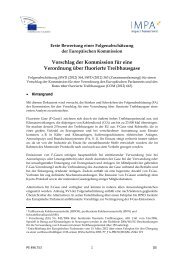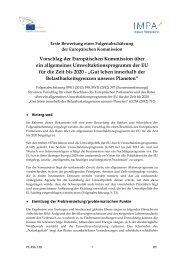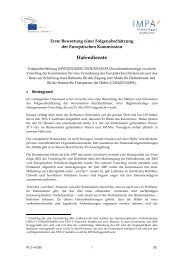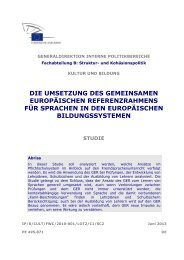Link to the study - European Parliament - Europa
Link to the study - European Parliament - Europa
Link to the study - European Parliament - Europa
Create successful ePaper yourself
Turn your PDF publications into a flip-book with our unique Google optimized e-Paper software.
Policy Department D: Budgetary Affairs<br />
____________________________________________________________________________________________<br />
The last line in Table 3: Development in cost estimations for <strong>the</strong> 9 reac<strong>to</strong>rs (plus s<strong>to</strong>rage facility St.<br />
Laurent) in million EUR normalizes <strong>the</strong> cost estimates for <strong>the</strong> reference year 2010 <strong>to</strong> make <strong>the</strong>m more<br />
comparable. As can be seen from <strong>the</strong>se numbers <strong>the</strong> cost estimates are fairly stable over <strong>the</strong> years<br />
and show no systematically accelerating trend.<br />
The importance of careful and reliable costs estimation can be seen from <strong>the</strong> experiences made<br />
during <strong>the</strong> real decommissioning works. So EDF noted in its internal audit report in March 2011 that<br />
because of difficulties caused by several administrative processes (as mentioned above) <strong>the</strong> costs can<br />
increase. Fur<strong>the</strong>r, faster use of <strong>the</strong> budget for Chooz A than expected was reported.<br />
The main cause for <strong>the</strong> above mentioned uncertainties is seen in CdC 2012 in <strong>the</strong> fact that <strong>the</strong><br />
approach used for <strong>the</strong> estimation by EDF consists of calculating cost brackets for all <strong>the</strong> parameters<br />
across all <strong>the</strong> facilities where a probability of occurrence is assigned (as explained above). CdC 2012<br />
recommends <strong>the</strong> use of uncertainty margins for costs, as <strong>the</strong>re is always a remaining scope of<br />
uncertainties because of lacking precedent experiences.<br />
The cost estimation for all EDF reac<strong>to</strong>rs being currently in operation<br />
The following overview of <strong>the</strong> costs estimations for <strong>the</strong> EDF fleet of 58 reac<strong>to</strong>rs demonstrates <strong>the</strong><br />
importance of <strong>the</strong> proper method used for <strong>the</strong>se estimations, that should be interlinked with timely<br />
preplanning of decommissioning works.<br />
EDF defined basic characteristics influencing directly <strong>the</strong> costs estimations for <strong>the</strong> dismantling 8 of 58<br />
reac<strong>to</strong>rs currently operated. All <strong>the</strong> reac<strong>to</strong>rs of <strong>the</strong> fleet are of <strong>the</strong> PWR type (pressurized water<br />
reac<strong>to</strong>rs). Here, a duration of 40 years for operation and subsequent immediate dismantling were<br />
assumed. The expenditure amounted <strong>to</strong> EUR 18,4 billion (price base 2010). This corresponds <strong>to</strong> <strong>the</strong><br />
equivalent of 19 % of <strong>the</strong> initial construction costs for <strong>the</strong> power plants concerned (EUR 96 billion in<br />
2010, overnight costs + interim interest (CdC 2012)).<br />
Costs for dismantling reac<strong>to</strong>rs in Germany, Belgium, Japan, UK, Sweden and USA were analysed and<br />
applied <strong>to</strong> <strong>the</strong> EDF PWR fleet in operation. In Table 4, <strong>the</strong> summarization of this comparison is presented.<br />
This demonstrates how costs range across countries and as a function of different estimation methods.<br />
8<br />
The stages following final shutdown of a nuclear power plant through <strong>to</strong> its decommissioning<br />
64


